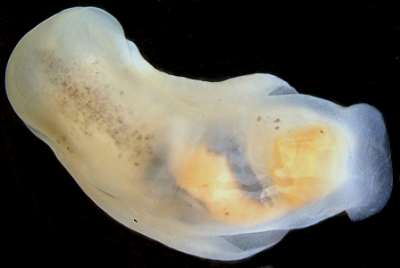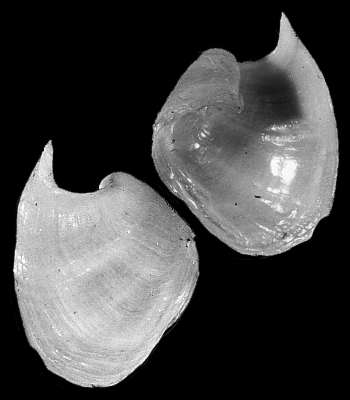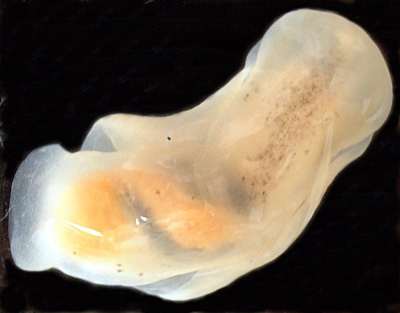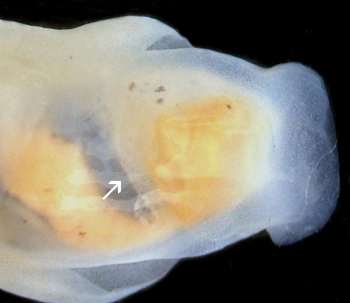

Melanochlamys lorrainae
(Rudman, 1968)
Order: CEPHALASPIDEA
Superfamily: PHILINOIDEA
Family: Aglajidae
DISTRIBUTION
New Zealand
PHOTO
Upper: Wattle Bay, near the entrance to the Manukau Harbour, Auckland, New Zealand, extreme low tide, buried in sand. 17 October 2005. Length of animal 24 mm. Photo: Shungo Kawagata. Lower:Shell of paratype. West side of Puponga Pt, Manukau Harbour, Auckland. 23 November 1965. Coll: N.Douglas. 8 x 6 mm. Photo: G.W. Batt.
The animal is identical in external shape to Melanochlamys cylindrica, but ranges in colour from pure white to a mottled grey. In anatomy it is typical of the genus Melanochlamys. The shape of the shell differentiates this species from the other white New Zealand aglajid, Philinopsis virgo, and the other New Zealand species of Melanochlamys, M. cylindrica.
The shell is solid and strongly calcified, having one and half whorls, thus appearing more bulloid than other species of Melanochlamys. It has been reported from widely separate parts of New Zealand (Manukau Harbour, Whangateau Peninsula, Parengarenga Harbour, Nelson). It grows to approximately 3 cm in length.
-
Rudman, W.B. (1968) Three new species of the Opisthobranch family Aglajidae from New Zealand. Transactions of the Royal Society of New Zealand, 10(23): 211-216.
-
Rudman, W.B. (1972) On Melanochlamys Cheeseman, 1881, a genus of the Aglajidae (Opisthobranchia: Gastropoda). Pacific Science, 26(1): 50-62, 8 figs
Rudman, W.B., 2005 (February 10) Melanochlamys lorrainae (Rudman, 1968). [In] Sea Slug Forum. Australian Museum, Sydney. Available from http://www.seaslugforum.net/find/melalorr
Related messages
Rediscovery of Melanochlamys lorrainae
October 21, 2005
From: Margaret Morley


Dear Bill,
Two single specimens of the rare opisthobranch, Melanochlamys lorrainae, which has not seen since the 1960's, have been found recently in New Zealand. I found one specimen on an Auckland Museum Institute Conchology Section fieldtrip (20 September 2005) to Paua, Parengarenga Harbour, Northland. It was just emerging from sand at extreme low tide in the vicinity of Zostera seagrass, northwest of Dog Island (34° 31' 19.1''S, 172° 56' 14.0''E). Length of animal 25 mm. Internal shell dissected by Dr Richard Willan who determined the species.
On a subsequent field trip organised by me (17 October 2005) to the type locality of M. lorrainae (Wattle Bay, near the entrance to the Manukau Harbour, Auckland, New Zealand, (37° 2' 49.1''S, 174° 35' 1.7''E) a single specimen (= topotype) was collected by Dr Wilma Blom at extreme low tide. It was found under a hump of silty sand near a small low reef. Length of animal 24 mm. Shell not yet dissected, identity to be confirmed. A piece of the parapodia has been preserved in ethanol for DNA analysis (anyone interested?). The remainder was then narcotised and preserved in ethanol. All material will be lodged in the collections of the Auckland War Memorial Museum. Photographs taken by Shungo Kawagata, Geomarine Research, Auckland (hand-held Fujifinepix 4MP digital camera and Leica microscope). Any further information would be gratefully received.
Both specimens found were covered in a thick coat of mucus. Specimens of Philine sp. and Amalda australis were living in the same habitat at both locations. Other references to note are Rudman (1968, 2005).
-
Rudman, W.B. (1968) Three new species of the Opisthobranch family Aglajidae from New Zealand. Transactions of the Royal Society of New Zealand, 10(23): 211-216.
-
Rudman, W.B. (1972) On Melanochlamys Cheeseman, 1881, a genus of the Aglajidae (Opisthobranchia: Gastropoda). Pacific Science, 26(1): 50-62, 8 figs
Auckland War Memorial Museum
martemp1@akmuseum.org.nz
Morley, M., 2005 (Oct 21) Rediscovery of Melanochlamys lorrainae. [Message in] Sea Slug Forum. Australian Museum, Sydney. Available from http://www.seaslugforum.net/find/15046
Dear Margaret,
This is indeed an interesting find. Quite a coincidence that two animals have been found within a few weeks of each other, at quite different localities. It's possible its apparent rarity is because of its burrowing habit. Certainly compared with M. cylindrica, which is commonly found intertidally in coralline algal turf, it is 'rare'. Melanochlamys lorrainae differs from M. cylindrica in colour and in the shape of the shell, which is much more flattened in M. cylindrica [see #12805]. Shungo Kawagata's photos are the only ones I know of this species. I did not have a camera whe I first studied these animals and until now, the species Fact Sheet has been illustrated solely by photos of the shell. In the close-up of the posterior part of the body alongside I have indicated the 'bottom' edge of the shell.
I hope this is just the first of many more contributions from you
Best wishes,
Bill Rudman
Aglajidae in New Zealand
February 12, 2005
From: Bill Rudman
To fill in a couple more gaps on the Forum, I have just posted pages on 2 more species of aglajid from New Zealand:
Philinopsis virgo
Melanochlamys lorrainae
Best wishes
Bill Rudman
